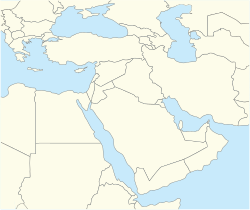
Back Bublos Afrikaans ጌባል Amharic جبيل Arabic جبيل ARZ Biblos AST Cübeyl Azerbaijani جبیل AZB Бібл Byelorussian Библос Bulgarian জুবাইল Bengali/Bangla
Byblos
جُبَيْل Jebeil | |
|---|---|
City | |
 Byblos Old Town | |
| Coordinates: 34°07′25″N 35°39′07″E / 34.12361°N 35.65194°E | |
| Country | Lebanon |
| Governorate | Keserwan-Jbeil |
| District | Byblos |
| Area | |
| • City | 4.16 km2 (1.61 sq mi) |
| • Metro | 17 km2 (7 sq mi) |
| Population | |
| • City | 40,000 |
| • Metro | 100,000 |
| Time zone | UTC+2 (EET) |
| • Summer (DST) | UTC+3 (EEST) |
| Dialing code | +961 |
| Website | www |
| Criteria | Cultural: iii, iv, vi |
| Reference | 295 |
| Inscription | 1984 (8th Session) |
Byblos (/ˈbɪblɒs/ BIB-loss; Greek: Βύβλος), also known as Jebeil, Jbeil or Jubayl (Arabic: جُبَيْل, romanized: Jubayl, locally Jbeil [ʒ(ə)beːl]; Phoenician: 𐤂𐤁𐤋, GBL, probably Gebal), is an ancient city in the Keserwan-Jbeil Governorate of Lebanon. The area is believed to have been first settled between 8800 and 7000 BC[1] and continuously inhabited since 5000 BC.[2] During its history, Byblos was part of numerous cultures including Egyptian, Phoenician, Assyrian, Persian, Hellenistic, Roman, Genoese, Mamluk and Ottoman. Urbanisation is thought to have begun during the third millennium BC and it developed into a city[3][2] making it one of the oldest cities in the world. It is a UNESCO World Heritage Site.[4]
It was in ancient Byblos that the Phoenician alphabet, likely the ancestor of the Greek, Latin and all other Western alphabets, was developed.[5]
- ^ Garfinkel, Yosef (2004). ""Néolithique" and "Énéolithique" Byblos in Southern Levantine Context". In E. J. Peltenburg; Alexander Wasse (eds.). Neolithic Revolution: New Perspectives on Southwest Asia in Light of Recent Discoveries on Cyprus. Oxbow Books. ISBN 978-1-84217-132-5. Retrieved 18 January 2012.
- ^ a b Dumper, Michael; Stanley, Bruce E.; Abu-Lughod, Janet L. (2006). Cities of the Middle East and North Africa. ABC-CLIO. p. 104. ISBN 1-57607-919-8. Retrieved 22 July 2009.
Archaeological excavations at Byblos indicate that the site has been continually inhabited since at least 5000 B.C.
- ^ Lorenzo Nigro (2007). "Aside the spring: Byblos and Jericho from village to town". In Nigro, Lorenzo (ed.). Byblos and Jericho in the early bronze I : social dynamics and cultural interactions : proceedings of the international workshop held in Rome on March 6th 2007 by Rome "La Sapienza" University. Università di Roma "La Sapienza". p. 35. ISBN 978-88-88438-06-1. Archived from the original on 2023-09-23. Retrieved 17 February 2017.
- ^ "Byblos". UNESCO. Retrieved 14 March 2018.
- ^ "Phoenician alphabet | Definition, Letters, & History | Britannica". www.britannica.com. Retrieved 2022-11-11.
© MMXXIII Rich X Search. We shall prevail. All rights reserved. Rich X Search

